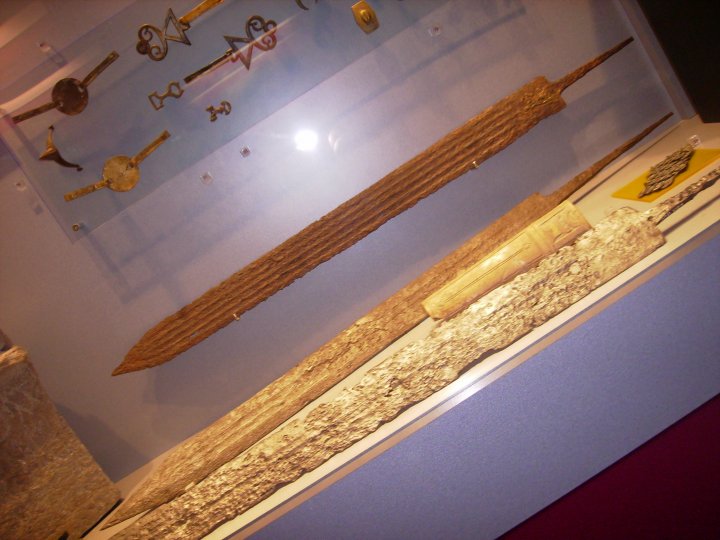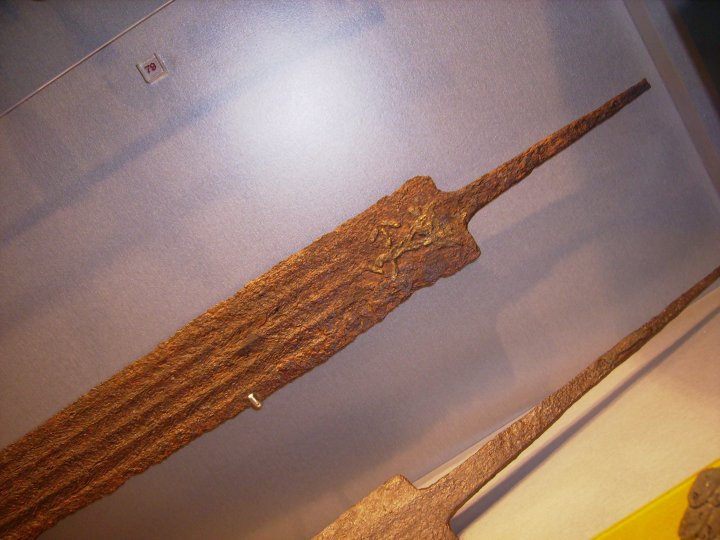| Author |
Message |
Ian Hutchison

Location: Louisiana / Nordrhein-Westholland Joined: 27 Nov 2007
Posts: 626
|
 Posted: Tue 08 Oct, 2013 2:29 pm Post subject: Multi-fullered migration era swords Posted: Tue 08 Oct, 2013 2:29 pm Post subject: Multi-fullered migration era swords |
 |
|
Hi,
Does anyone know if there are any multi-fullered migration era swords where the fullers terminate before the end of the blade?
Also, if you have any pics of original migration era blades, I'd love to see them posted here.
Best,
Ian
'We are told that the pen is mightier than the sword, but I know which of these weapons I would choose.' - Adrian Carton de Wiart
|
|
  |
 |
Luka Borscak

|
 Posted: Tue 08 Oct, 2013 3:40 pm Post subject: Posted: Tue 08 Oct, 2013 3:40 pm Post subject: |
 |
|
Here is a nice multi fullered spatha from Archeological Museum in Zagreb. A bit earlier than what we generally call migration era, but maybe it will still be useful to you.
 Attachment: 68.56 KB Attachment: 68.56 KB

 Attachment: 67.15 KB Attachment: 67.15 KB

|
|
  |
 |
Ian Hutchison

Location: Louisiana / Nordrhein-Westholland Joined: 27 Nov 2007
Posts: 626
|
 Posted: Tue 08 Oct, 2013 6:26 pm Post subject: Posted: Tue 08 Oct, 2013 6:26 pm Post subject: |
 |
|
Thanks Luka, these multi-fullered blades are really beautiful in my opinion. It is too bad we don't see many of them, basically non-existent in the production world .
'We are told that the pen is mightier than the sword, but I know which of these weapons I would choose.' - Adrian Carton de Wiart
|
|
  |
 |
Matthew Bunker

Location: Somerset UK Joined: 02 Apr 2009
Posts: 483
|
 Posted: Wed 09 Oct, 2013 3:37 am Post subject: Posted: Wed 09 Oct, 2013 3:37 am Post subject: |
 |
|
Multiple fullered spathas seem to most common in the Late Roman Iron Age (3rd and 4th century) and really begin to drop out of use by the start of the Migration period in the early 5th century.
There are some excellent examples from the early 3rd century at the Mosegard museum which came from the bog deposit at Illerup Adal which, like the example from Zagreb, are probably from Roman fabricae.
Examples from the 4th century, from the bog deposits at Nydam, Vimose, Kragehul and Ejsbøl Mose can be found in the national museum in Copenhagen and at the Nydam boat museum at Schloss Gottorf in Schleswig.
I've got photos of all of these if you're interested but they're a bit too early for 'Migration' period, where most blades seem to have either broad, shallow fullers or no fullers at all.
"If a Greek can do it, two Englishman certainly can !"
|
|
  |
 |
Ian Hutchison

Location: Louisiana / Nordrhein-Westholland Joined: 27 Nov 2007
Posts: 626
|
 Posted: Wed 09 Oct, 2013 11:48 am Post subject: Posted: Wed 09 Oct, 2013 11:48 am Post subject: |
 |
|
| Matthew Bunker wrote: | Multiple fullered spathas seem to most common in the Late Roman Iron Age (3rd and 4th century) and really begin to drop out of use by the start of the Migration period in the early 5th century.
There are some excellent examples from the early 3rd century at the Mosegard museum which came from the bog deposit at Illerup Adal which, like the example from Zagreb, are probably from Roman fabricae.
Examples from the 4th century, from the bog deposits at Nydam, Vimose, Kragehul and Ejsbøl Mose can be found in the national museum in Copenhagen and at the Nydam boat museum at Schloss Gottorf in Schleswig.
I've got photos of all of these if you're interested but they're a bit too early for 'Migration' period, where most blades seem to have either broad, shallow fullers or no fullers at all. |
Hi Matthew,
Yeah, I'd love to see those pictures. Those were what I had in mind, I mistakenly thought they were Migration period.
'We are told that the pen is mightier than the sword, but I know which of these weapons I would choose.' - Adrian Carton de Wiart
|
|
  |
 |
Matthew Bunker

Location: Somerset UK Joined: 02 Apr 2009
Posts: 483
|
 Posted: Wed 16 Oct, 2013 10:44 am Post subject: Posted: Wed 16 Oct, 2013 10:44 am Post subject: |
 |
|
Apologies for the delay in getting back to you Ian.
Rather than have you wade through lots of photos in my online albums, i thought it'd be easier to scan the relevant pages from Miks'
"Studien zur römischen Schwertbewaffnung in der Kaiserzeit:" who, conveniently, lumps them all together.
This scan shows some of the Danish bog swords from the 4th century.
Those coded '146.xx' are from Ejsbol (Northern deposit), the '536.xx' blades are from Nydam context 1B or 1A/B and 381.1 is from Kragehul.
There are many other multi-fullered blades in Miks but they tend to be a bit earlier so I didn't know if they'd be of interest?
 Attachment: 240.33 KB Attachment: 240.33 KB
[ Download ]
"If a Greek can do it, two Englishman certainly can !"
|
|
  |
 |
Andy Ternay

|
 Posted: Wed 16 Oct, 2013 6:54 pm Post subject: Posted: Wed 16 Oct, 2013 6:54 pm Post subject: |
 |
|
Matthew, thank you for posting that scan! I have been looking for an image of the multi-fullered Kragehul sword for a while. Do you know if you have a photo of that one in your online albums? I have looked and not seen it unless I simply missed it.
"Precious swords...since there for a thousand winters they had rested in the earth's embrace." ~ Beowulf 3048 - 50
|
|
  |
 |
Kai Lawson

|
 Posted: Wed 16 Oct, 2013 8:58 pm Post subject: Posted: Wed 16 Oct, 2013 8:58 pm Post subject: |
 |
|
Some of those look really nice--do you have stats on any of them?
"And they crossed swords."
--William Goldman, alias S. Morgenstern
|
|
  |
 |
Ian Hutchison

Location: Louisiana / Nordrhein-Westholland Joined: 27 Nov 2007
Posts: 626
|
 Posted: Wed 16 Oct, 2013 9:48 pm Post subject: Posted: Wed 16 Oct, 2013 9:48 pm Post subject: |
 |
|
Matthew: Very nice, thanks for that.
'We are told that the pen is mightier than the sword, but I know which of these weapons I would choose.' - Adrian Carton de Wiart
|
|
  |
 |
Matthew Bunker

Location: Somerset UK Joined: 02 Apr 2009
Posts: 483
|
 Posted: Thu 17 Oct, 2013 2:12 am Post subject: Posted: Thu 17 Oct, 2013 2:12 am Post subject: |
 |
|
Andy,
I do have pics of the Kragehul but when I last visited Copenhagen in 2005, digi-cams were rubbish compared to today and memory cards were tiny, so one had to be very selective, so those images I do have are mostly close ups of hilts and scabbards. The blade pics aren't good enough to show much detail.
I'm back in Denmark in the first week of November for a museum 'roadtrip' (Copenhagen to Haderslev via Roskilde, Lejre and Jelling and then back to Copenhagen), armed with a decent DSLR, a new Canon Cybershot and a clutch of 32Gb memory cards.
I will be taking pictures of everything and will then post links to the albums.
Kai,
Yes, lengths etc are detailed in Miks so tell me which you're interested in and I'll post them up.
For example, the detail for Nydam 29 is
Total length 928mm
Blade length 797mm
Max. blade width 56mm
Tang length 131mm (took me ages to figure out that 'tang' in German is 'angel')
Ribbon-shaped cross section, four fullers. Possibly pattern welded.
He also gives details of hilt furniture where appropriate.
"If a Greek can do it, two Englishman certainly can !"
|
|
  |
 |
|
Michael Pikula
Industry Professional
Location: Madison, WI Joined: 07 Jun 2008
Posts: 411
|
 Posted: Thu 17 Oct, 2013 8:23 am Post subject: Posted: Thu 17 Oct, 2013 8:23 am Post subject: |
 |
|
Thank you for this topic and the images. It has been a while since I thought about this style of blade and I think I will have to revisit the form at some point. It is vastly under represented and very beautiful.
Most of the texts that have these style of swords are not in English, and I am wondering about the hilt construction... It seems like foil/wire that has been formed over wood?
|
|
   |
 |
Matthew Bunker

Location: Somerset UK Joined: 02 Apr 2009
Posts: 483
|
 Posted: Thu 17 Oct, 2013 9:32 am Post subject: Posted: Thu 17 Oct, 2013 9:32 am Post subject: |
 |
|
Michael,
That's right; thin contoured sheet, silver or bronze, formed over wooden grips and wooden upper and lower guards to create a complete covering (sometimes over peening blocks as well).
These images of one of the Nydam hilts shows the silver sheet and the hollow left inside:-
 Attachment: 139.5 KB Attachment: 139.5 KB
[ Download ]
 Attachment: 99.31 KB Attachment: 99.31 KB
[ Download ]
"If a Greek can do it, two Englishman certainly can !"
|
|
  |
 |
|
|

